
LIFT intersects 22 m at 1.05% Li2O at its Fi Southwest pegmatite, Yellowknife Lithium Project, NWT
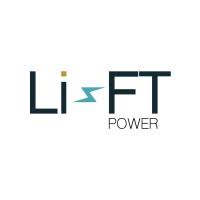
Li-FT Power Ltd. (TSX-V: LIFT) (OTCQX: LIFFF) (Frankfurt: WS0) is pleased to report assays from 8 drill holes completed at the Fi Southwest, BIG West, Nite, & Fi Boye pegmatites within the Yellowknife Lithium Project located outside the city of Yellowknife, Northwest Territories (Figure 1). Drilling intersected significant intervals of spodumene mineralization, with the following highlights:
Highlights:
- YLP-0199: 22 m at 1.05% Li2O, (Fi Southwest)
including: 9 m at 1.87% Li2O
- YLP-0195: 15 m at 1.0% Li2O, (Nite)
including: 2 m at 1.42% Li2O
and including: 8 m at 1.26% Li2O
- YLP-0189: 4 m at 1.11% Li2O, (Fi Boye)
Discussion of Results
This week’s drill results are from 1,325 m drilled across eight holes, including the first hole of the 2024 winter program at Fi Southwest as well as 2023 results from the Nite, BIG West, and Fi Boye pegmatites. A table of composite calculations, general comments related to this discussion, and a table of collar headers are provided towards the end of this section.
David Smithson, SVP, Geology of LIFT comments, “Results from the deep drilling at Nite this week continue to impress with hole 195 intercepting 15 m at 1.0% Li2O at 250 m from the surface. This is the second deep hole we have drilled on the Nite structure following on from 10 m at 1.4% Li2O drilled at the same level in 2023. The Fi Southwest dyke was similarly impressive this week returning 22 m at 1.0% Li2O near to the surface. Drilling to date on the Fi Southwest dyke has defined over 900 m of good shallow mineralization so we are very excited to test the rest of the structure to depth in the 2024 drill program currently underway in the field.”

Figure 1 – Location of LIFT’s Yellowknife Lithium Project. Drilling has been thus far focused on the Near Field Group of pegmatites which are located to the east of the city of Yellowknife along a government-maintained paved highway, as well as the Echo target in the Further Afield Group.
The Fi-SW dyke strikes over at least 1.1 km on surface with an average outcropping width of approximately 20 m. The dyke dips between 60°-80° to the east-southeast and trends towards the north-northeast. Drilling of Fi SW shows that it ranges from a single 20-40 m wide dyke to 2-3 dykes of similar cumulative width within a 50-70 m wide corridor.
YLP-0199 is the first hole drilled in the 2024 winter program and was collared to test the Fi SW pegmatite approximately 150 m from its northern mapped extent and 50 m beneath the surface. Drilling intersected 4 m and 15 m wide pegmatites separated by 3 m of country rock with assays returning a wall-to-wall composite of 1.05% Li2O over 22 m that includes 9 m of 1.87% Li2O (Table 1 & 2, Figures 2 & 3).
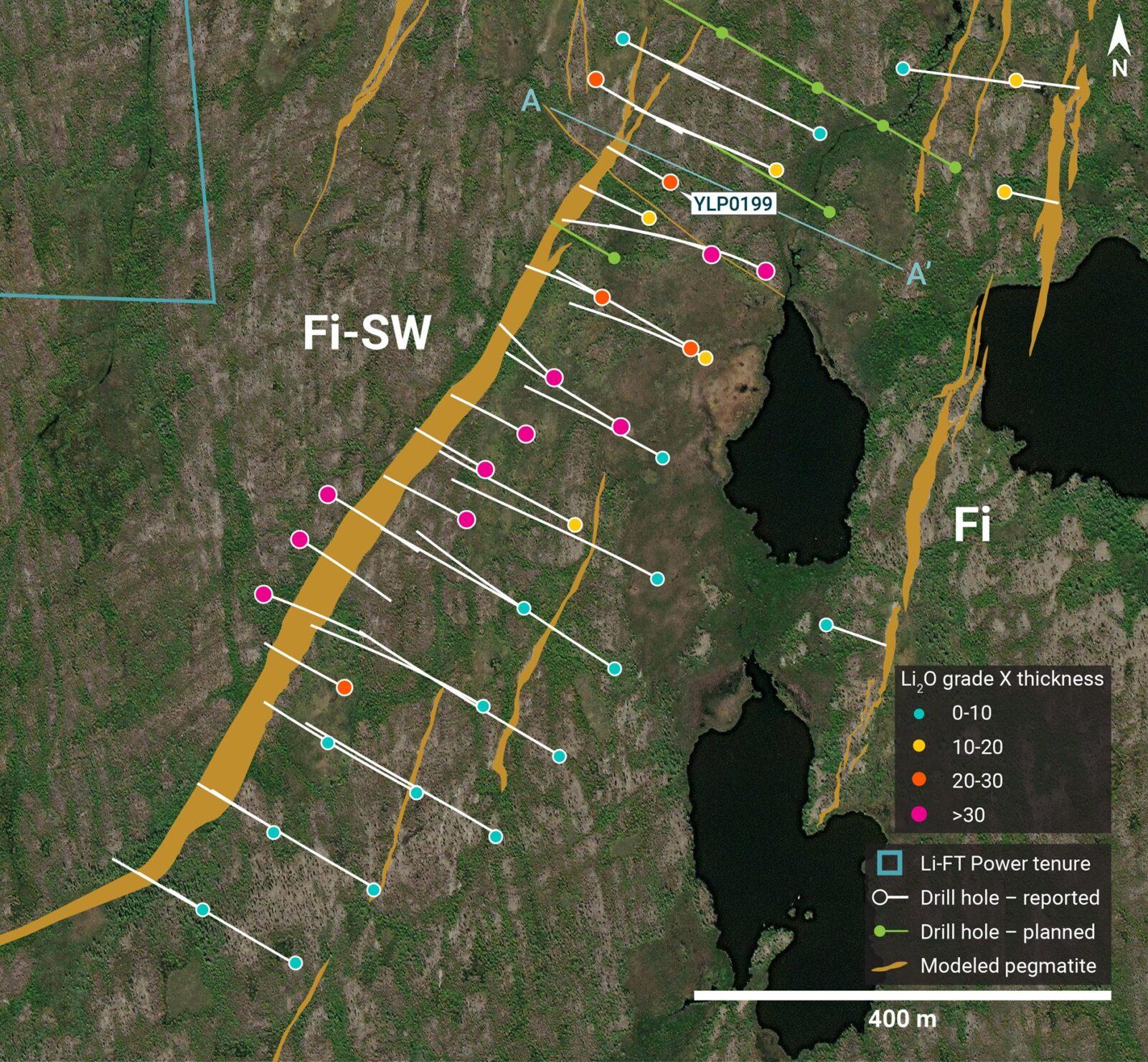
Figure 2 – Plan view showing the surface expression of the Fi Southwest pegmatite with diamond drill holes reported in this press release.

Figure 3 – Cross-section illustrating YLP-0199 with results as shown in the Fi Southwest pegmatite dyke with a 22 m interval of 1.05% Li2O.
Nite Pegmatite
The Nite pegmatite complex comprises a north-northeast trending corridor of parallel-trending dykes that is exposed for at least 1.4 km of strike length and dips approximately 50°-70° degrees to the east. The northern part of this complex consists of a main dyke flanked by one or more thinner dykes whereas the southern part comprises a fanning splay of 5-10 thinner dykes that is up to 200 m wide.
YLP-0192 explored the Nite pegmatite approximately 400 m from its northern end, 150 m beneath the surface, and 100 m downdip of previously released YLP-0152 (1.24% Li2O over 5 m). Drilling intersected five pegmatite dykes ranging from 1-7 m wide for cumulative pegmatite of 19 m over 45 m of core. The deepest of these three dykes returned 0.87% Li2O over 6 m that includes 2 m of 1.99% Li2O.
YLP-0195 was drilled on a section 300 m south of YLP-0192 to test the Nite pegmatite 700 m from its northern end, 250 m beneath the surface, and 200 m downdip of YLP-0138 (1.51% Li2O over 12 m). New drilling intersected a 17 m wide dyke flanked by several 1-8 m dykes for cumulative 28 m of pegmatite over 59 m of core. Sampling of the thick dyke returned an assay composite of 1.00% Li2O over 15 m that includes subintervals of 1.42% Li2O over 2 m and 1.26% Li2O over 8 m (Table 1 & 2, Figures 4 & 5).
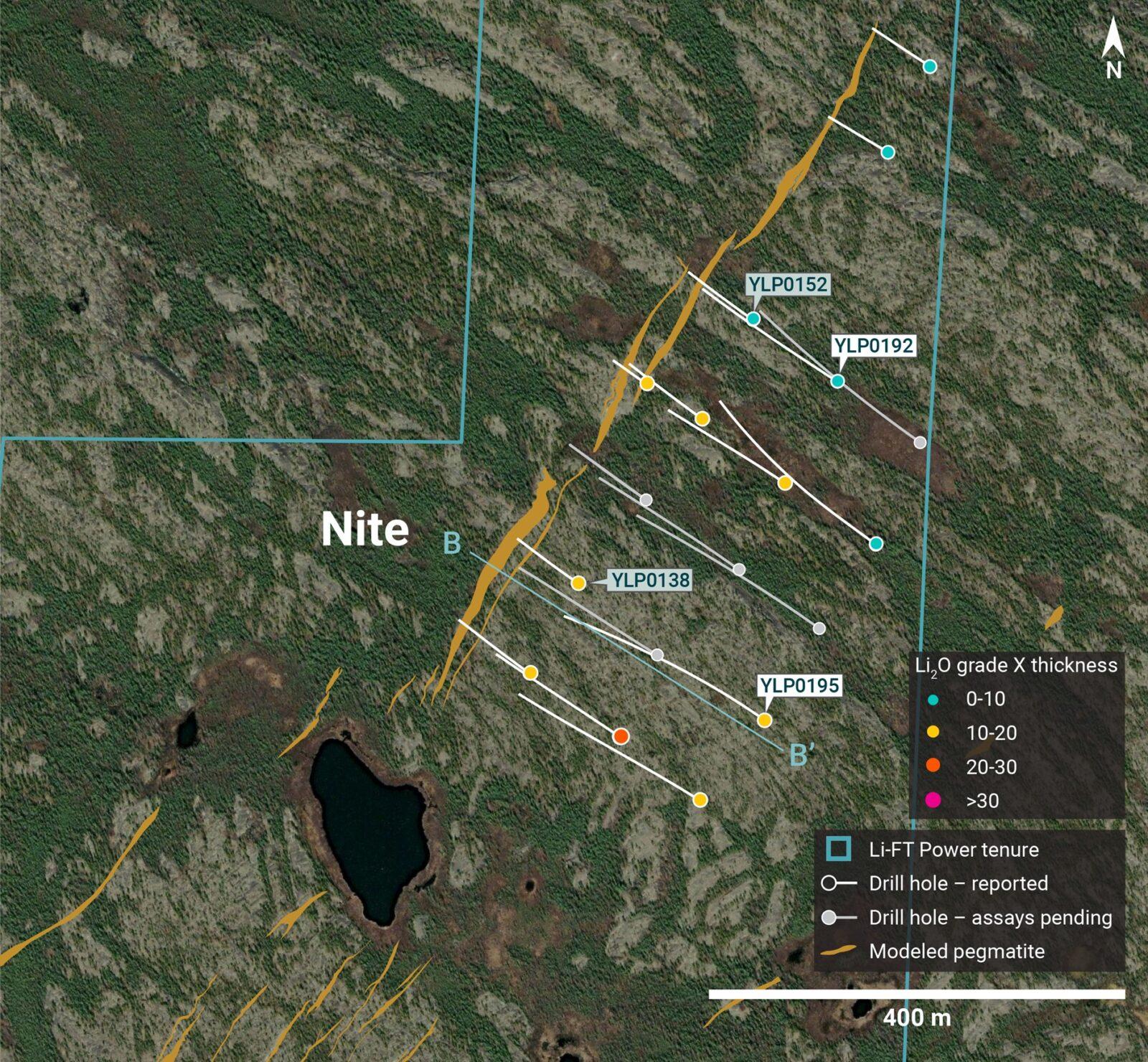
Figure 4 – Plan view showing the surface expression of the Nite pegmatite with diamond drill holes reported in this press release.
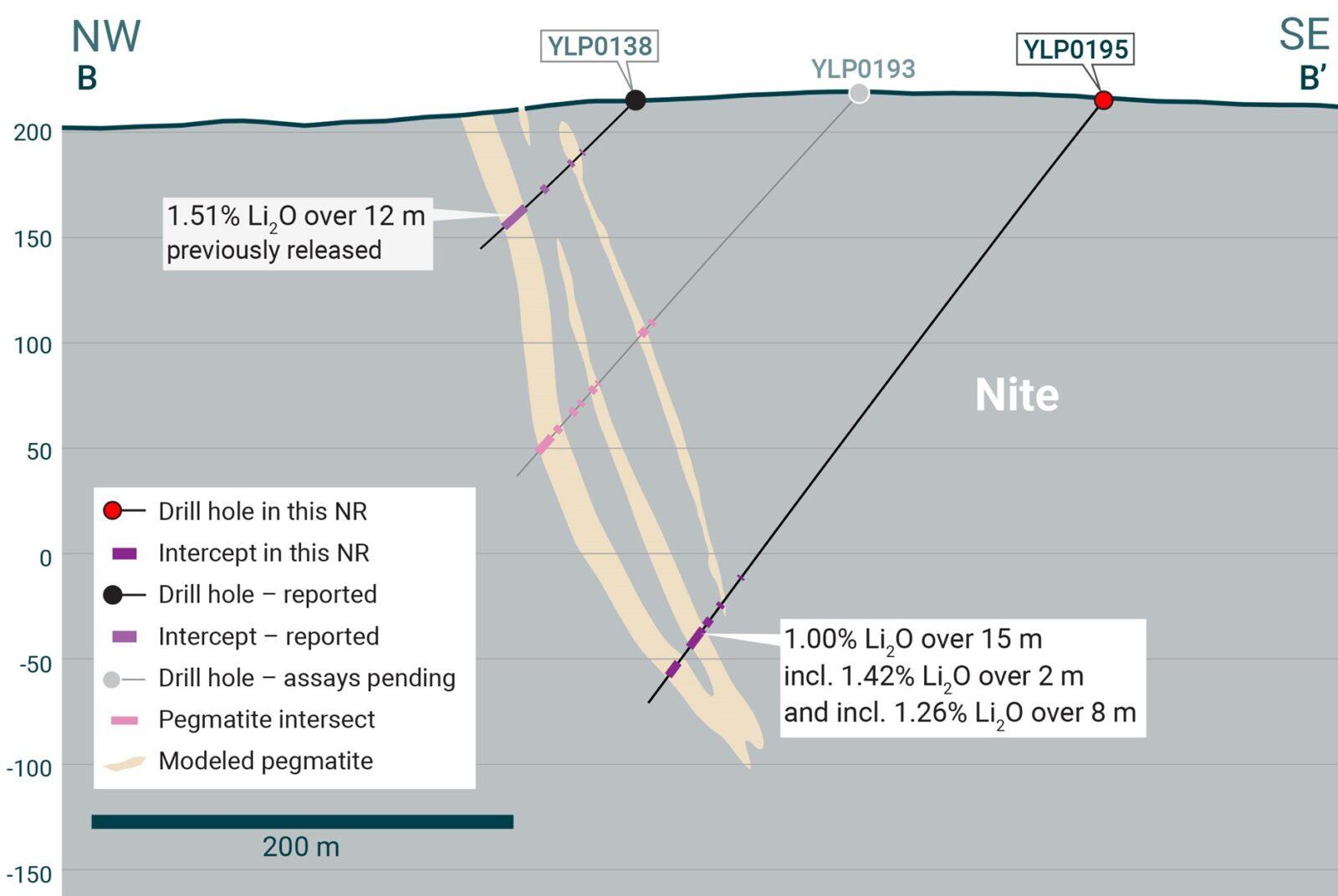
Figure 5 – Cross-section of YLP-0195 which intersected the Nite pegmatite dyke with a 15 m interval of 1.00% Li2O.
BIG West Pegmatite
The BIG West pegmatite complex comprises a northeast-trending corridor of parallel-trending dykes that is exposed for at least 1.5 km along strike and is steeply west dipping to subvertical. The complex is bound by two relatively continuous dyke structures that are 50-100 m apart in the northern half of the corridor and 150 m apart in the south. These dykes are here referred to as the east- (EB) and west-bounding (WB) dykes. This week’s results are described from southern- to northern-most.
YLP-0180 tested the WB dyke approximately 450 m from its southern mapped extent and <25 m beneath the surface, as well as 50 m and 100 m up-dip of previously released holes (YLP-0160, 0164) that both returned negligible grades. Drilling intersected a single 11 m wide pegmatite dyke that returned an assay composite of 0.54% Li2O over 5 m, which includes 1 m of 1.60% Li2O.
YLP-0185 was collared just west of the EB dyke and 200 m from the northern mapped extent of the BIG West complex to target the WB dyke approximately 50 m beneath the surface and 100 m up-dip of YLP-0191 (see below). Drilling intersected a single one-metre-wide pegmatite dyke that returned negligible grade.
YLP-0191 was drilled on the same section as YLP-0185 but was collared just east of the EB dyke, so that it tested this dyke within 25-50 m of the surface and the WB dyke at 150 m depth. Drilling shows that these bounding dykes are separated by ~100 m of country rock, with the EB dyke comprising two 11-12 m dykes flanked by 2-3 m wide dykes for cumulative 28 m of pegmatite over 70 m of drill core whereas WB comprises a single 27 m wide dyke. Significant assays were returned only from the EB dyke and includes composites of 0.74% Li2O over 11 m (including 1.48% Li2O over 4 m) and 0.54% Li2O over 12 m (with 1.44% Li2O over 3 m).
YLP-0183 is the most northerly hole drilled on the BIG West complex in 2023, just ~150 m from its northern mapped extent and targeting the EB dyke within 25 m of the surface. Drilling intersected a 13 m wide dyke flanked by several 1-7 m wide dykes for 33 m of pegmatite over 69 m of drill core. Assays from the thick dyke returned a composite of 0.51% Li2O over 6 m that includes a 1 m interval of 1.16% Li2O whereas the flanking dykes returned negligible grade (Table 1 & 2, Figures 6 & 7).

Figure 6 – Plan view showing the surface expression of the BIG West pegmatite with diamond drill holes reported in this press release.
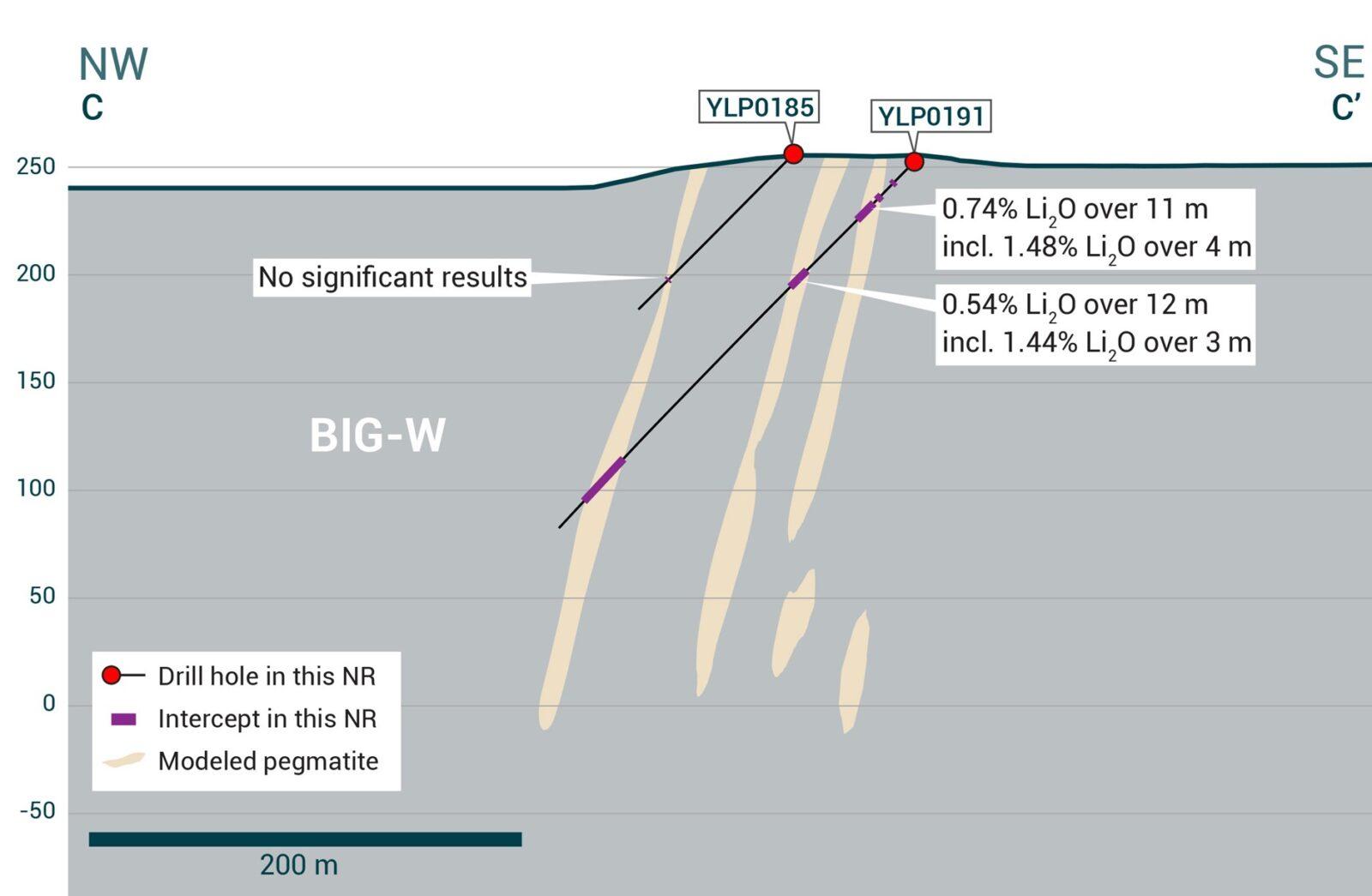
Figure 7 – Cross-section of YLP-0191 which intersected the BIG West pegmatite dyke with a 11 m interval of 0.74% Li2O.
Fi Boye Pegmatite
The Fi Boye pegmatite comprises a corridor of mostly north-south striking, steeply east-dipping, dykes that run parallel to, and lie 500-700 m west of, the Fi Main complex. The Fi Boye corridor has at least 1.7 km of striking length, contains between 1-5 dykes, and ranges from approximately 10-200 m in width. The two holes reported below comprise all the drilling done on Fi Boye in 2023.
YLP-0189 was drilled to test the Fi Boye dyke approximately 200 m from its northern mapped extent and 50 m beneath the surface. Drilling intersected a 14 m wide dyke flanked by several 1-2 m wide dykes for cumulative pegmatite of 16 m over 31 m. The thick dyke returned an assay composite of 1.11% Li2O over 4 m (Table 1 & 2, Figure 8).

Figure 8 – Plan view showing the surface expression of the Fi Boye pegmatite with diamond drill holes reported in this press release.
Table 1 – Assay highlights for drill holes reported in this press release.
| Hole No. | From (m) | To (m) | Interval (m) | Li2O% | Dyke |
| YLP-0180 | 10 | 15 | 5 | 0.54 | BIG West |
| inc | 13 | 14 | 1 | 1.60 | |
| YLP-0183 | 18 | 24 | 6 | 0.51 | BIG West |
| inc | 21 | 22 | 1 | 1.16 | |
| YLP-0185 | No significant results | BIG West | |||
| YLP-0189 | 15 | 19 | 4 | 1.11 | Fi Boye |
| YLP-0191 | 27 | 38 | 11 | 0.74 | BIG West |
| inc | 29 | 33 | 4 | 1.48 | |
| and | 71 | 83 | 12 | 0.54 | |
| inc | 72 | 75 | 3 | 1.44 | |
| YLP-0192 | 176 | 182 | 6 | 0.87 | Nite |
| Inc | 178 | 180 | 2 | 1.99 | |
| YLP-0195 | 311 | 326 | 15 | 1.00 | Nite |
| inc | 311 | 313 | 2 | 1.42 | |
| and inc | 318 | 326 | 8 | 1.26 | |
| YLP-0199 | 58 | 80 | 22 | 1.05 | Fi SW |
| inc | 66 | 75 | 9 | 1.87 | |
Drilling Progress Update
The Company has concluded its 2023 drill program at the Yellowknife Lithium Project with 34,238 m completed. Currently, LIFT has reported results from 189 out of 198 diamond drill holes (33,309 m).
General Statements
Six of the eight holes described in this news release were drilled broadly perpendicular to the dyke orientation so that the true thickness of reported intercepts will range somewhere between 65-100% of the drilled widths. A collar header table is provided below.
Two of the three holes drilled at the north end of the BIG West complex (YLP-0185, 0191) were drilled broadly downdip because collar locations for drilling perpendicular to dyke orientation fall within Big Hill Lake. The true thickness of these downdip intercepts will range between 40-50% of the drilled widths.
Mineralogical characterization for the YLP pegmatites is in progress through hyperspectral core scanning and X-ray diffraction work. Visual core logging indicates that the predominant host mineral is spodumene.
Table 2 – Drill collars table of reported drill holes in this press release
| Drill Hole | NAD83 | Easting | Northing | Elevation (m) | Azimuth (°) | Dip (°) | Depth (m) | Dyke |
| YLP-0180 | Zone 11 | 653,779 | 6,933,153 | 208 | 115 | 45 | 41 | BIG West |
| YLP-0183 | Zone 11 | 654,217 | 6,933,778 | 204 | 115 | 45 | 87 | BIG West |
| YLP-0185 | Zone 11 | 654,202 | 6,933,730 | 206 | 298 | 45 | 102 | BIG West |
| YLP-0189 | Zone 12 | 371,157 | 6,942,629 | 253 | 84 | 45 | 141 | Fi Boye |
| YLP-0191 | Zone 11 | 654,251 | 6,933,702 | 202 | 295 | 45 | 237 | BIG West |
| YLP-0192 | Zone 11 | 647,717 | 6,936,538 | 203 | 298 | 50 | 255 | Nite |
| YLP-0195 | Zone 11 | 647,678 | 6,936,208 | 215 | 298 | 52 | 360 | Nite |
| YLP-0199 | Zone 12 | 371,462 | 6,941,023 | 251 | 302 | 46 | 102 | Fi SW |
QA/QC & Core Sampling Protocols
All drill core samples were collected under the supervision of LIFT employees and contractors. Drill core was transported from the drill platform to the core processing facility where it was logged, photographed, and split by diamond saw prior to being sampled. Samples were then bagged, and blanks and certified reference materials were inserted at regular intervals. Field duplicates consisting of quarter-cut core samples were also included in the sample runs. Groups of samples were placed in large bags, sealed with numbered tags to maintain a chain-of-custody, and transported from LIFT’s core logging facility to ALS Labs laboratory in Yellowknife, Northwest Territories.
Sample preparation and analytical work for this drill program were carried out by ALS. Samples were prepared for analysis according to ALS method CRU31: individual samples were crushed to 70% passing through 2 mm (10 mesh) screen; a 1,000-gram sub-sample was riffle split (SPL-21) and then pulverized (PUL-32) such that 85% passed through 75-micron (200 mesh) screen. A 0.2-gram sub-sample of the pulverized material was then dissolved in a sodium peroxide solution and analysed for lithium according to ALS method ME-ICP82b. Another 0.2-gram sub-sample of the pulverized material was analysed for 53 elements according to ALS method ME-MS89L. All results passed the QA/QC screening at the lab, all inserted standards and blanks returned results that were within acceptable limits.
Qualified Person
The disclosure in this news release of scientific and technical information regarding LIFT’s mineral properties has been reviewed and approved by Ron Voordouw, Ph.D., P.Geo., Partner, Director Geoscience, Equity Exploration Consultants Ltd., and a Qualified Person as defined by National Instrument 43-101 Standards of Disclosure for Mineral Projects (NI 43-101) and member in good standing with the Northwest Territories and Nunavut Association of Professional Engineers and Geoscientists (NAPEG) (Geologist Registration number: L5245).
About LIFT
LIFT is a mineral exploration company engaged in the acquisition, exploration, and development of lithium pegmatite projects located in Canada. The Company’s flagship project is the Yellowknife Lithium Project located in Northwest Territories, Canada. LIFT also holds three early-stage exploration properties in Quebec, Canada with excellent potential for the discovery of buried lithium pegmatites, as well as the Cali Project in Northwest Territories within the Little Nahanni Pegmatite Group.
MORE or "UNCATEGORIZED"
Red Pine Discovers Significant Gold Mineralization in Faulted Extension of the Jubilee Shear on the Wawa Gold Project
Red Pine Exploration Inc. (TSX-V: RPX) (OTCQB: RDEXF) is pleased ... READ MORE
F3 Announces Closing of Private Placement for Aggregate Gross Proceeds of C$8 Million
F3 Uranium Corp. (TSX-V: FUU) (OTC Pink: FUUFF) is pleased to ann... READ MORE
Collective Mining Announces Closing of Concurrent Financings for Gross Proceeds of C$46.35 Million
Collective Mining Ltd. (NYSE: CNL) (TSX: CNL) is pleased to ann... READ MORE
ARIS MINING ANNOUNCES CLOSING OF US$450 MILLION SENIOR NOTES OFFERING TO FUND REDEMPTION OF OUTSTANDING 6.875% SENIOR NOTES
Aris Mining Corporation (TSX: ARIS) (NYSE-A: ARMN) announces t... READ MORE
Rare Element Resources Receives Final Approval Required to Commence Operations of Rare Earth Demonstration Plant in Wyoming
Staffing in place and operations shakedown underway Rare E... READ MORE












